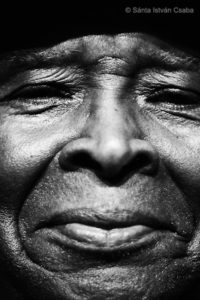I went to Budapest for spring break — to introduce a photo exhibit by my Transylvanian-born friend  Sánta István Csaba and help jury the 10th annual Müpa Budapest Jazz Showcase/Talent Exchange, held in the modernist musem and multi-theater complex on the east bank of the icy Danube Feb 3 – 5.
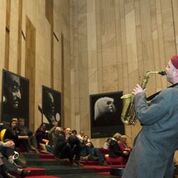
Viktor Tóth played alto briefly to open the photo exhibition – (and Saturday night at the Budapest Jazz Club) – photo by Janos Posztos Müpa Budapest
As I wrote in my  DownBeat article, the sound of the 12 sets I heard was jazz as we think of it now — virtuosic horns, piano/keyboards and/or guitar, upright or electric basses and drums; vocalists singing standards, spicing up r&b grooves, toying with electronics; popular rhythms addressed through personal perspectives.
There was a faint aura of the music of the Roma — gypsies — in the air, emanating not only from the quartets led by pianist Gyula Balogh and drummer Toni Snétberger, with members from that community. It was hard to define — no overt Django Reinhardt, figurations or repertoire, but a tinge of darkness and interiority in those bands, and what I imagined was witchy wailing by singer Petra Kész with her performance art-like trio Cymbal Rush (video of that show below).
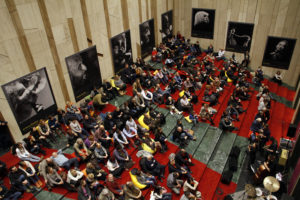
On walls, from left: Anthony Braxton, Chico Hamilton, Charles McPherson . . . Carla Bley, Charles Lloyd, Frank Wess. Photos by Sánta István Csaba
Still, as in the Saturday night jam session at the Budapest Jazz Club – a very cool hangout which advertised Jeff “Tain” Watts, Joe Lovano and Steve Coleman as coming attractions supplementing local groups, the vibe was familiar from my travels in Armenia, the Azores, Berlin, Cuba, Denmark, Gambia, Italy, St. Petersberg, Tampere, Trinidad, Ukraine as well as the States. Whatever a community’s resources, there are commonalities in the jazz world everywhere, this capital of Central Europe most definitely included.
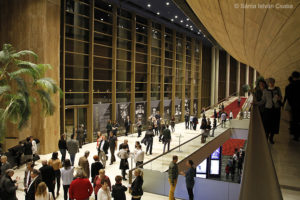
Second grouping of Jazzonance portraits in Müpa
The singing in English, allusions to Monk (as I took the approach of alto saxophonist Gábor Baris’s Version), reverence for Coltrane (especially by alto/soprano saxist Tamás Ludányi) and interest in Herbie Hancock bleeding over to pop stars such as J Dilla (by drummer David Hodek, grooving with American pianist Paul Cornish and bassist Joshua Crumbly) and Betty Wright (smoldering singer Janka Vörös’ finale), with Santa’s 2.5 x 2 meter closeups of U.S. jazz masters on the walls  –“Jazzonance” was Müpa’s exhibit title  — and companionable journo/jurists from Sofia, Slovenia, London, plus Budapest-based freelancer Kornél Zipernovszky and the generously great Hungarian guitarist Gyula Babos – let me feel almost at home, while refreshed by particular differences.
Such as the architecture — 19th and 20th century glories, variously preserved, restored or abandoned. Proud museums, palaces and six-story apartment buildings with ground-floor retail shops and cafés, on concentric circular boulevards. The Gellert Hill Cave, thermal baths and church in St. Ivan’s grottos. Trams running up each side of the river, the Danube’s bridges rebuilt since Nazi destruction in WWII. The old market, stalls hung with paprika-colored sausages, an instructive display of wild mushrooms tucked in a corner.  The Castle District of hilly Buda, overlooking the plain of Pest.
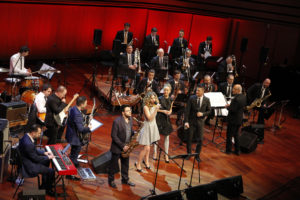
Past winners of the Talent Exchange in the Gala Concert finale, singing and blowing on a swinging arrangement of Lerner and Loewe’s “Almost Like Being in Love” backed by the Franz Liszt Academy of Music’s Senior Big Band, directed by Attila László. Photo by Sántá István Csaba
All contrasting with but complementary to the Jazz Showcase/Talent Exchange (wherein some of the Hungarians travel to perform at London’s 606 Club, and others are booked into events via the Hungarian Jazz Federation, part of the European Jazz Network). Müpa’s decade-old program struck me as an effort rooted in an artistically sophisticated city, one cognizant of its complex, conflicted past and evidently eager to thrive in the present, the better for whatever’s to come.
As usual, creative music with drive and feeling seems to well up as a significant if not essential ingredient in a culture, with such ambitions embraced towards those very ends. The basics of individual expression amid group collaborations performed for the entertainment and enlightenment of general audiences have been well established here. The integration of attractive, useful ideas coming from myriad sources is, at least superficially, high. I had just a quick visit, and no doubt experienced a mere slip of what’s happening in Budapest. But I liked what I heard and saw.

